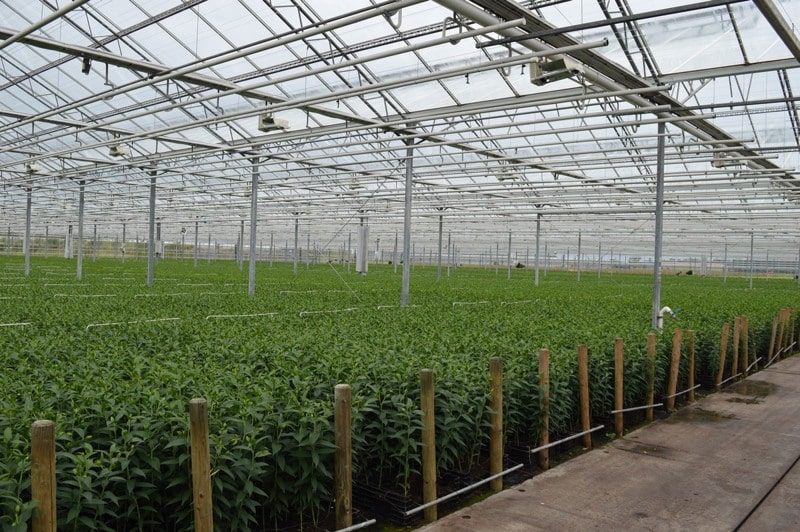This article was originally published in Dutch; you can read the original version here at Bloemen Planten Nieuws
The spring water at Klaver Flowers’ farm in Ethiopia may be abundant, but contains a lot of sodium and bicarbonate. To get the electroconductivity (EC) down, the grower until now used reverse osmosis, which is effective but comes at a price.
When Raymond Lescrauwaet first proposed using AQUA4D® tech to treat the water, owner Gert-Jan Klaver was initially skeptical – but curious. “I thought ‘if it doesn’t help then it doesn’t hurt’. We had seen good results elsewhere in roses and vegetables, so I was eager to try it.”
From left to right Gert-Jan Klaver, Jesse Bergsma and Raymond Lescrauwaet
Double-digit water savings
Immediate results after starting an initial trial in part of the crop were substantial water savings. This could vary greatly according to changing weather conditions, but ended up at about 10% on average. On top of this, the AQUA4D® treatment’s efficient mineral dissolution also meant a further 10% savings in fertilizer use. Since the farm has expanded considerably in recent years – now growing mainly gypsum and limonium on some 50 acres – this was a nice bonus.
Additionally, soil moisture, which is important for proper formation of the root system, is clearly more uniform. “We grow flowers on beds and a good distribution of water is very important in this respect,” says Gert-Jan over a cup of coffee in the brand-new office in Heerhugowaard, Netherlands. “Previously, the water sank down in a cone shape, the horizontal distribution left much to be desired. Moreover, we often saw the sides of the beds drying out. We also see now that, especially with the gypsum, the roots are less sensitive to salt.”
Improving plant health and quality
With AQUA4D® technology, the molecular structure of the irrigation water improves through a resonance technique developed in Switzerland. The water structure refines, the fluidity or surface tension improves, the water takes up minerals better and, together with the nutrients, is more easily absorbed by plants.
With all these effects in the water and soil, it is hardly surprising that the plant above ground also benefits. “We would like to achieve above-average quality, the stems are preferably all 80 cm and weigh at least 30-35 grams. To achieve that, everything has to be right, and since we started AQUA4D we are indeed seeing slightly longer and somewhat heavier stems. In addition, the soil structure is looser and we see a little less sun burn on the leaves.”
Animation: How AQUA4D® saves water and keeps soils moist for longer
Further success in Europe
More or less synchronous with the field tests in Ethiopia, an AQUA4D project was also started in the greenhouses in Heerhugowaard, Netherlands. This is a completely different crop (lilies, in crates, under glass) and under completely different climatic weather conditions, but when it comes to issues such as savings and quality improvement, they are also eager for optimization here.
The initial findings were almost identical: a 10% saving on water, a more even moisture distribution, and better flow on the crop. Moreover, Gert-Jan and cultivation manager Jesse Bergsma note that the pipes have become cleaner: there are less deposits in the pipes and filters also need to be replaced less often.
Plug & play technology
After thorough initial checks, the AQUA4D® system is installed on the main pipeline and then runs automatically – without maintenance or consumables. On the farm, after an initial unit was installed to irrigate 3 ha, three units have now been installed that supply the entire farm, approximately 14 ha of production, with treated irrigation water. “This number is not primarily correlated to the amount of water flowing through the AQUA4D treatment tube, but more of the entire water column itself because even with stagnant water it has its effect,” explains Raymond Lescrauwaet of the now 12-year-old importing company AQUA4D-Lescrauwaet based in Hilversum.
“The art of the technology is to find the precise resonant frequencies of the water, while counteracting any outside interference as much as possible. That is why we do all kinds of environmental measurements in advance at various points in the greenhouse and especially where water or power lines run or, as is the case here, there is a high-voltage mast nearby. If you have all that understood, then basically all the water that is in that particular greenhouse circuit is treated to the maximum.”
Getting the most out of this innovative tech also involves committed and open-minded growers, Raymond adds. “That’s absolutely the case at Klaver Flowers, with a progressive and accessible management team, and motivated cultivation managers like (former) Rob, Danny and Jesse.”
Looking ahead
All parties are pleased with the findings, particularly Klaver Flowers with their return on investment and savings – not to mention the improved quality of the flowers.
“It’s not magic,” concludes Gert-Jan, “we measure consistently and observe clear improvements. We hope to further expand our farm in Ethiopia in the near future and with today’s knowledge that will certainly include an AQUA4D system.”
Netherlands
Greenhouse Irrigation
Water Savings
Fertilizer Savings

Photo: Klaver Flowers greenhouse in the Netherlands
“It’s not magic; we measure consistently and observe clear improvements. We hope to further expand our farm in the near future and with today’s knowledge that will certainly include an AQUA4D system.” – Gert-Jan Klaver



